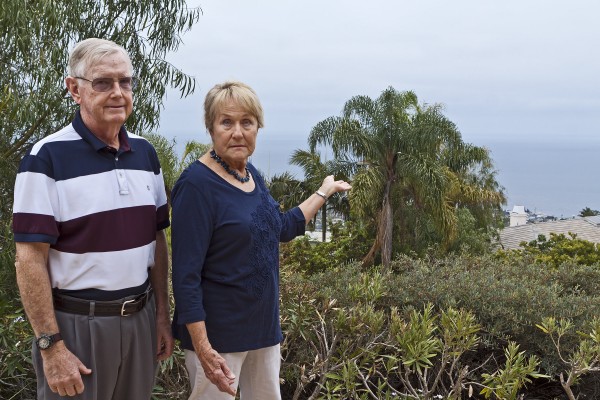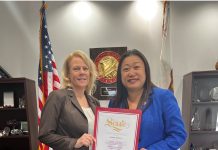
Establishing a process to negotiate over removing offending vegetation, like the palm taking up the sweet spot at Jim and Mimi Healey’s home, is what the view ordinance is intended to address.
After a year’s worth of committee hearings, Laguna Beach’s City Council on Tuesday finally reviewed a new ordinance to govern view regulation, though Mayor Elizabeth Pearson made it clear the special session was intended to listen to residents’ concerns rather than to pass a new law immediately.
“You have an open-minded Council here,” she said. “We are not making a decision tonight.”
An informal consensus did seem to emerge over a few priorities that included setting view claim fees at an affordable level, ejecting an indemnity clause proposed by staff and leaving intact an existing hedge-height ordinance.
“At the end of the day we are going to adopt something…put it in place and then figure out whether it’s working,” said Council member Steve Dicterow, who added that most of the really hard work had already been done by the committee.
Council members Kelly Boyd, the ordinance’s chief proponent, and Dicterow assured the packed house they would consider comments made by 30 speakers, along with any e-mailed missives, as they reviewed and tweaked the ordinance before bringing a revised document back to the full Council.
Indeed, since the eight-member view equity committee was appointed by Boyd last year, they’ve held eight public hearings; visited the homes of residents with view-blockage claims; visited officials of Rancho Palos Verdes, on whose court-tested law Laguna’s is loosely modeled; and spent countless hours conferring with city staff, redrafting and fielding e-mails and phone calls.
Local attorney and committee chair Larry Nokes recounted that Boyd asked the committee to come up with a legal, enforceable and reasonable law. He believes they’ve succeeded on those counts in devising an ordinance that includes the right to establish and record a view and restore pre-existing views to the date when a property was purchased.
“I think we do have the makings of a very good remedy,” he said. “Give it a chance.”
The draft ordinance still had its overall detractors, such as Bob Hartman, who claimed he was “very disappointed” with what the committee came up with, a sentiment shared by Greg Gilroy.
Others were more optimistic. “I’m really happy with the ordinance,” said longtime resident Liza Stewart. Likewise, Ginger Osborne, complimented the committee for coming up with “what I consider to be a compromise.”
The draft presented Tuesday, available on the city’s web site, allows a property owner to make a claim to restore “significant” views that have been blocked by vegetation within 500 feet of the property line.
The process laid out in the ordinance mandates that disgruntled property owners first attempt to come to terms with the neighbor whose vegetation is obstructing their vista. Failing that, the owner can apply for a notice of intent to file a view restoration claim. The city then asks the vegetation owner to attend a mediation meeting. If that doesn’t work, the claim proceeds and will be heard by a view restoration committee at a noticed public hearing.
The current draft stipulates that the claimant should pay the cost of the mediator and the initial cost of taming the offending vegetation, with the vegetation owner required to foot the bill for all subsequent maintenance going forward.
Residents and Council members seized on this point, questioning either the potentially steep fees, or the burden placed on the claimant, or both. Rancho Palos Verdes charges for an array of fees, ranging from $198 for a vegetation analysis to $5,100 for a view permit, a staff report says.
“This shouldn’t be an ordinance that works only for the rich,” said Mayor Pro Tem Bob Whalen.
“The cost should be felt by the people with the trees,” said resident Margarita Martin, voicing an opinion of many present.
Two issues raised in a previous draft got some closure Tuesday. The hedge height ordinance had been repealed as a stand-alone measure and merged into an earlier draft at the recommendation of staff to avoid potential confusion between the two. And a clause was written into the proposal that requires the property owner that brings a view claim to indemnify the city against any liability and pay expenses if the city’s ordinance faces a legal challenge.
The new draft reinstated the hedge height ordinance, but tweaked the definition of a hedge to exclude trees, and it retained indemnification language.
Residents vociferously opposed both measures, as did council members, who promised to correct them.
City Manager John Pietig took the heat off the committee over indemnification, saying staff had insisted on the language. However, in the face of such fierce opposition, he admitted that it was “clearly a problem” and suggested the Council revisit it.
As an attorney, Dicterow said he saw the merits of pushing for a legal shield, but as a policy maker he did not. “We ought to be defending our policies,” he said. “We are putting them together for the benefit of everybody, so we should bear that cost. I think it’s fair that we all share that burden together.”
Residents called on the council to commit to enforcing the statute once enacted.
John Keith pointed out he won a hedge height claim against his neighbor, but it took him a full year to get the city’s code enforcement personnel to respond when the neighbor allowed the hedge to grow back.
Committee member Sue Kempf urged heeding the experience of Rancho Palos Verdes’ officials, who attributed their success in avoiding claims by resolving most disputes through use a professional mediator, rather than an arborist or staff member.
Pietig concluded that the ordinance might not yet be a perfect solution, but was a starting point. “We may have to try some things now and tweak them later,” he said, noting that the Council had already budgeted $325,000 annually to help cover costs of implementing the ordinance.
Nokes praised the contributions of the drafting committee, including Chris Toy, Planning Commission member Ken Sadler, Design Review Board member Roger McErlane, landscape architects Bob Borthwick and Susan Whitin, architect Morris Skendarian, and emergency disaster preparedness committee member Sue Kempf.
“Thanks to Kelly for bringing this forward and making it happen,” said Iseman.




